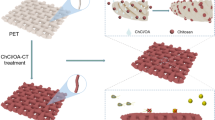Abstract
The chitosan is fixed in an amide group of activated carboxyl groups and biological primary amino groups of nonwoven PET for antibacterial properties. Uncoated materials have fewer wetting properties and are less biocompatible. The objectives of the study were to evaluate surface chemical compositions and biocompatibility, antibacterial, and hydrophilic properties of polyester fabrics grafted with chitosan oligomers and after being activated by atmospheric pressure plasmas. A 2% 14.8 mg/cm2 uncolored PET woven fabric was dissolved in chitosan solution. Atmospheric pressure plasmas were used to activate polyester fabrics grafted with chitosan oligomers on both sides. Cell proliferation assay was performed for the biocompatibility study. The American Association of Textile Chemists and Colorists method was used to measure the width of the antibacterial zone and the Japanese Industrial Standard was used to count the number of bacterial colonies. Chitosan-coated and -activated uncolored PET woven fabric showed fewer percentage free carbon (p < 0.0001), higher percentage free oxygen to free carbon ratio (p < 0.0001), higher percentage free nitrogen to free carbon ratio (p = 0.0453), and higher percentage free oxygen plus free nitrogen to free carbon ratio (p < 0.0001) than untreated PET woven fabric. The dynamic contact angle of a water droplet and the wicking time were shorter for chitosan-coated and -activated uncolored PET woven fabric than untreated PET weaved fabric (p < 0.0001 for all). Chitosan coating leads to PET woven fabric being higher biocompatible, wettable, and antibacterial than untreated PET woven fabric.







Similar content being viewed by others
Data Availability
The data used to support the findings of this study are available from the corresponding author upon request.
Abbreviations
- PET:
-
Polyethylene terephthalate
- UV light:
-
Ultraviolet light
- XPS:
-
X-ray photoelectron spectroscopy
- SEM:
-
Scanning electron microscope
References
Dai, T., Tanaka, M., Huang, Y. Y., & Hamblin, M. R. (2011). Chitosan preparations for wounds and burns: Antimicrobial and wound-healing effects. Expert Review of Anti-Infective Therapy, 9(7), 857–879.
Dong, S., Guo, P., Chen, G. Y., **, N., & Chen, Y. (2020). Study on the atmospheric cold plasma (ACP) treatment of zein film: Surface properties and cytocompatibility. International Journal of Biological Macromolecules, 153, 1319–1327.
Huang, C. Y., & Chen, C. L. (2002). The effect of plasma surface modification from a rotary plasma reactor on the styrene grafting onto a polypropylene surface. Surface and Coatings Technology, 153(2–3), 194–202.
Huh, M. W., Inn-Kyu, K., Lee, D. H., Kim, W. S., Lee, D. H., Park, L. S., Min, K. E., & Seo, K. H. (2001). Surface characterization and antibacterial activity of chitosan-grafted poly(ethylene terephthalate) prepared by plasma glow discharge. Journal of Applied Polymer Science, 81(11), 2769–2778.
Kruse, C., Anderson, T., Wilson, C., Zuhlke, C., Alexander, D., Gogos, G., & Ndao, S. (2013). Extraordinary shifts of the Leidenfrost temperature from multiscale micro/nanostructured surfaces. Langmuir, 29(31), 9798–9806.
Rodrigues, S., Dionísio, M., López, C. R., & Grenha, A. (2012). Biocompatibility of chitosan carriers with application in drug delivery. J Funct Biomater, 3(3), 615641.
Rodrigues, S., Dionísio, M., López, C. R., & Grenha, A. (2012). Biocompatibility of chitosan carriers with application in drug delivery. J Funct Biomater, 3(3), 615–641.
Vigneshwaran, N. (2009). Modification of textile surfaces using nanoparticles. Surface Modification of Textiles, 2009, 164–184. https://doi.org/10.1533/9781845696689.164
Yu-Bin, C., Pei-Chi, T., Mien-Win, W., Tien-Hsiang, H., & Shan-hui, H. (2008). A study on chitosan modification of polyester fabrics by atmospheric pressure plasma and its antibacterial effects. Fibers and Polymers, 9(3), 307–311.
Xu, Y., Sun, J., & Phong, K. P. (2022). Research on teaching resource reform of innovation and entrepreneurship education for Business Administration Specialty. Educational Administration: Theory and Practice, 28(03), 83–96. https://doi.org/10.17762/kuey.v28i03.484
Funding
This work was sponsored in part by National Natural Science Foundation of China (51973144, 51741301).
Author information
Authors and Affiliations
Contributions
The SL confirms sole responsibility for the following: study conception and design, data collection, analysis and interpretation of results, and manuscript preparation.
Corresponding author
Ethics declarations
Ethics Approval
This study Soochow University Ethics Committee has confirmed that no ethical approval is required.
Consent to Participate
Not applicable.
Consent for Publication
Not applicable.
Conflict of Interest
The authors declare no competing interests.
Additional information
Publisher's Note
Springer Nature remains neutral with regard to jurisdictional claims in published maps and institutional affiliations.
Rights and permissions
Springer Nature or its licensor (e.g. a society or other partner) holds exclusive rights to this article under a publishing agreement with the author(s) or other rightsholder(s); author self-archiving of the accepted manuscript version of this article is solely governed by the terms of such publishing agreement and applicable law.
About this article
Cite this article
Chen, G., Zhou, C., **ng, L. et al. Study on the Effect of Chitosan Modification Technology on Antibacterial Properties of Textiles. Appl Biochem Biotechnol 196, 1966–1976 (2024). https://doi.org/10.1007/s12010-023-04621-8
Accepted:
Published:
Issue Date:
DOI: https://doi.org/10.1007/s12010-023-04621-8



